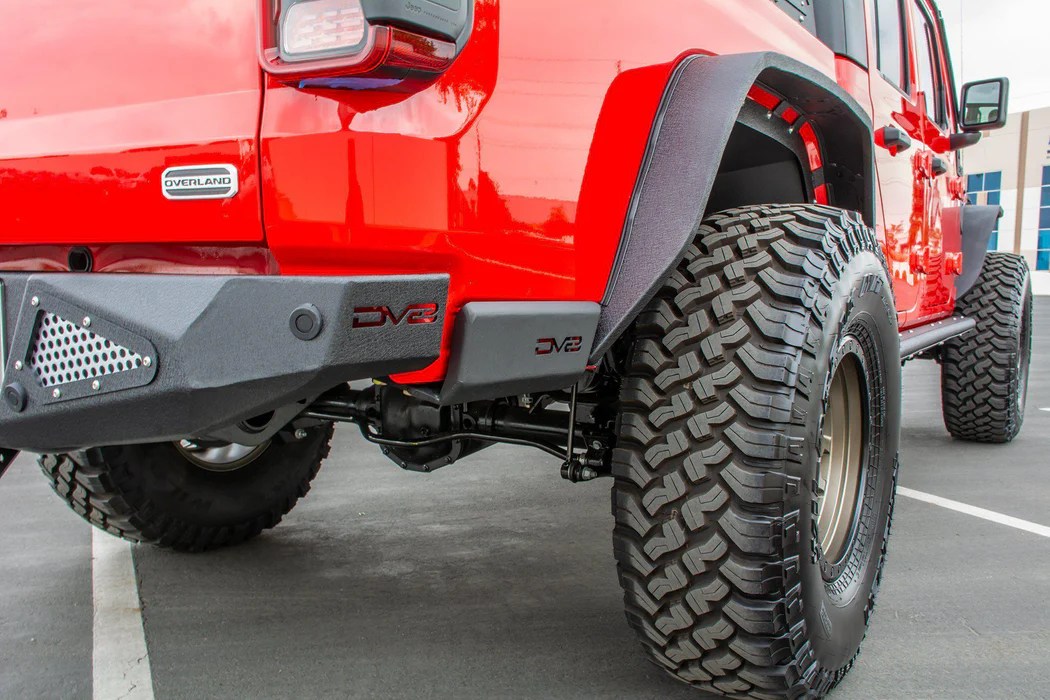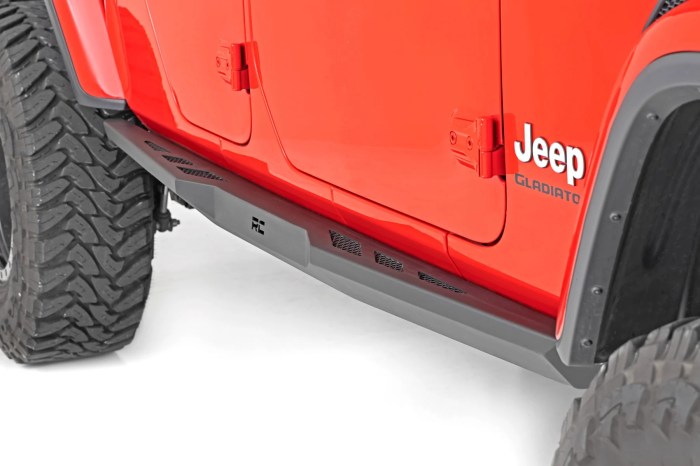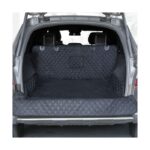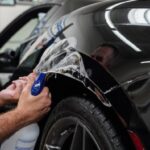Top-rated rock sliders for Jeep Gladiator? Yeah, dude, let’s talk serious upgrades. Protecting your rig’s undercarriage is crucial, especially if you’re hitting the trails hard. We’re diving deep into the best brands, materials, and installation tips to make sure your Gladiator stays looking fresh and ready for anything. Think of this as your ultimate guide to rock slider nirvana.
This guide covers everything from choosing the right brand and material (steel vs. aluminum – it’s a real debate!) to tackling the installation yourself. We’ll break down the pros and cons of different designs, help you understand the impact on your Jeep’s performance, and even answer some frequently asked questions. Get ready to level up your Gladiator’s off-road game!
Top-Rated Rock Slider Brands for Jeep Gladiator
Choosing the right rock sliders for your Jeep Gladiator is crucial for off-road protection and peace of mind. These robust side armor not only safeguard your vehicle’s body from trail hazards but also provide convenient steps for easier access. This section will delve into some of the top brands, their features, and what sets them apart.
Top-Rated Rock Slider Brands and Their Features
The market offers a wide variety of rock sliders, each with its own strengths and weaknesses. The following table summarizes five top-rated brands, highlighting their key features and price ranges. Note that prices can fluctuate based on retailer and specific model.
| Brand | Key Features | Price Range | Customer Review Summary |
|---|---|---|---|
| Smittybilt | Durable steel construction, textured powder coat finish, integrated steps, relatively affordable. | $300 – $600 | Generally positive reviews, praising durability and value. Some complaints about finish chipping over time. |
| RBP | Stylish designs, available in various finishes (black, chrome, etc.), often includes integrated step, typically steel construction. | $400 – $700 | Mixed reviews; some praise the aesthetics, while others report issues with durability in extreme off-road conditions. |
| Iron Cross | Heavy-duty steel construction, known for strength and resilience, often features a robust mounting system, generally more expensive. | $600 – $900 | Excellent reviews emphasizing exceptional durability and strength. Price point is a frequent consideration. |
| JCR Off-Road | High-quality materials (steel or aluminum options available), customizable options, robust construction, premium pricing. | $700 – $1200 | Positive reviews, highlighting the quality and customization options. The higher price point is a common discussion point. |
| Genright | High-end steel construction, precise fitment, excellent craftsmanship, known for superior durability and a high price tag. | $800 – $1500 | Mostly excellent reviews, emphasizing strength and precision. Cost is a significant factor for many customers. |
Rock Slider Material Comparison: Steel vs. Aluminum
Rock sliders are commonly constructed from steel or aluminum. Each material presents advantages and disadvantages:Steel offers superior strength and durability, better resisting impacts from rocks and other obstacles. However, steel sliders are heavier, potentially impacting fuel economy, and are generally more expensive.Aluminum, on the other hand, is lighter, leading to improved fuel efficiency and potentially easier installation. It’s also often less expensive than steel.
However, aluminum is less resistant to bending and damage from significant impacts compared to steel. The choice depends on your priorities – strength versus weight and cost.
Warranty Policies of Top Three Brands
Warranty policies vary significantly among manufacturers. Understanding these policies is important for long-term protection. This section focuses on the top three brands from the table above (Smittybilt, Iron Cross, and JCR Off-Road), providing a general overview. Specific warranty terms should always be verified on the manufacturer’s website or with the retailer.Smittybilt typically offers a limited warranty, often covering manufacturing defects for a specific period.
The exact duration and terms vary by product.Iron Cross often provides a longer warranty period than Smittybilt, generally covering defects for a more extended timeframe. Specific details are available on their website.JCR Off-Road, being a premium brand, usually offers a comprehensive warranty with excellent customer service, often covering defects for an extended period and sometimes offering repair or replacement options.
Again, check their website for the most up-to-date details. The length and comprehensiveness of the warranty often reflect the higher initial cost.
Rock Slider Mounting and Installation

Installing rock sliders on your Jeep Gladiator is a rewarding project that significantly enhances its off-road capabilities and protection. This process typically involves several steps, from prepping the vehicle to securing the sliders, and requires careful attention to detail to ensure a secure and long-lasting installation. Remember, safety is paramount throughout the entire process.
The installation process for rock sliders varies slightly depending on the specific brand and model, but the general steps remain consistent. Proper preparation and understanding of the process are key to a successful installation.
Necessary Tools and Safety Precautions
Before beginning, gather the necessary tools and take the appropriate safety precautions. This will streamline the installation process and minimize the risk of injury or damage.
- Tools: Socket wrench set (metric and SAE), ratcheting wrenches, drill with appropriate drill bits (if necessary), safety glasses, work gloves, jack stands, jack, torque wrench, penetrating oil, and a level.
- Safety Precautions: Always work in a well-ventilated area. Wear safety glasses to protect your eyes from debris. Use jack stands to securely support your vehicle while it’s lifted. Never work under a vehicle supported only by a jack. Ensure the parking brake is engaged.
Typical Installation Process
The following steps Artikel a typical installation process. Remember to consult your specific rock slider’s installation instructions for detailed guidance.
- Preparation: Clean the Jeep Gladiator’s frame rails where the sliders will mount. Remove any dirt, rust, or debris to ensure a proper fit and prevent corrosion.
- Positioning: Carefully position the rock sliders against the frame rails, ensuring proper alignment. Use a measuring tape and level to verify that the sliders are level and symmetrical.
- Drilling (If Necessary): Some rock sliders may require drilling pilot holes to align with existing holes or to create new mounting points. Use a drill press for accuracy, if possible.
- Bolting: Securely bolt the rock sliders to the frame rails using the provided hardware. Start with hand-tightening to ensure proper alignment, then tighten progressively using a torque wrench to the manufacturer’s specified torque settings. This prevents over-tightening and potential damage.
- Verification: After tightening all bolts, double-check the alignment and stability of the rock sliders. Gently rock the sliders to ensure a secure fit.
Common Installation Challenges and Solutions
Several challenges can arise during rock slider installation. Understanding these potential problems and their solutions can save time and frustration.
- Rust or Corrosion: If the frame rails are rusted or corroded, it may be difficult to achieve a secure connection. Cleaning the frame rails thoroughly with a wire brush and applying a rust converter before installation can resolve this issue.
- Misalignment: Improper alignment can lead to an uneven or unstable installation. Carefully measure and double-check alignment at each step to prevent this. Using a level is crucial for this step.
- Difficult Bolt Access: Some bolt locations may be difficult to access. Using extensions or specialized sockets can aid in reaching these areas.
- Stripped Bolts: If the bolts are stripped, replace them immediately. Using the correct size and type of bolt is essential.
Step-by-Step Visual Guide
Imagine this as a series of snapshots during the installation.
So you’re looking at top-rated rock sliders for your Jeep Gladiator? Totally get it, protecting your rig is key. But while you’re upgrading, remember that maintaining your other vehicles is just as important. If you’ve got a Chevy truck with transmission shudder, check out this guide on How to fix transmission shudder in Chevy trucks before it becomes a bigger problem.
Then, get back to those sweet Gladiator rock sliders—you deserve the best protection for both your rides!
- Step 1: The Jeep Gladiator is securely lifted and supported by jack stands. The frame rails are meticulously cleaned, removing any obstructions. A visual inspection ensures the area is free from rust or significant damage.
- Step 2: A rock slider is held in place against the frame rail. A measuring tape and level are used to ensure perfect alignment and levelness. This ensures symmetrical placement and prevents future issues.
- Step 3: The first few bolts are hand-tightened to pre-align the slider. The level is rechecked to verify alignment. This prevents unnecessary work if misalignment is discovered early.
- Step 4: All bolts are tightened progressively and methodically, using a torque wrench to reach the manufacturer’s specified torque. This ensures consistent pressure and prevents damage to the frame or bolts.
- Step 5: A final inspection ensures all bolts are securely tightened and the slider is firmly mounted. A gentle rocking motion tests the stability and ensures no movement.
Rock Slider Features and Functionality
Choosing the right rock sliders for your Jeep Gladiator is crucial for both protection and performance. Understanding the different designs, features, and their impact on your Jeep’s capabilities will help you make an informed decision. This section dives into the specifics of rock slider design, key features to consider, and their effect on your Gladiator’s off-road geometry.
Rock sliders are more than just a stylish addition; they’re a vital piece of off-road armor. Their design significantly influences their effectiveness and suitability for different terrains. Let’s explore the variations available.
Rock Slider Design Comparison
Different rock slider designs offer unique advantages and disadvantages. The choice often depends on your typical off-roading style and priorities.
| Design Type | Advantages | Disadvantages | Best Use Cases |
|---|---|---|---|
| Tube Sliders | Lightweight, good ground clearance, relatively inexpensive, strong in bending situations | Can be less protective against direct impacts, potentially less robust than plate sliders against large rocks | High-speed desert running, mild to moderate rock crawling |
| Plate Sliders | Excellent protection against impacts, very strong, can incorporate additional features like integrated steps | Heavier than tube sliders, can reduce ground clearance if not carefully designed, more expensive | Serious rock crawling, extreme off-roading, situations requiring maximum protection |
| Hybrid Sliders | Combine the strengths of tube and plate designs (e.g., a plate bottom with tube bracing), often offer a good balance of protection, weight, and cost | Can be more complex to manufacture, potentially more expensive than simple tube or plate designs | Moderate to serious rock crawling, a balance between protection and weight is desired |
Key Features to Consider When Selecting Rock Sliders, Top-rated rock sliders for Jeep Gladiator
Beyond the basic design, several key features significantly impact a rock slider’s performance and overall value.
- Mounting Points: Robust mounting points are crucial. Sliders should be securely attached to the Jeep’s frame, not just the body, to withstand significant impacts. The number and placement of mounting points influence strength and rigidity.
- Ground Clearance: Sufficient ground clearance is essential for navigating obstacles. The slider’s design and mounting position directly affect how much clearance you retain.
- Material: Steel is the most common material, offering good strength and durability. However, aluminum offers a lighter alternative, though it may be less resistant to impacts.
- Integration with Other Accessories: Consider whether the sliders are compatible with other accessories you plan to install, such as recovery points or steps.
- Finish: A durable powder coat finish protects against rust and corrosion, extending the sliders’ lifespan.
Impact on Approach and Departure Angles
Rock sliders, while offering protection, can slightly affect a Jeep Gladiator’s approach and departure angles. The extent of this impact depends on the slider’s design and how far they extend beyond the frame.
Generally, well-designed sliders minimize the negative impact on approach and departure angles. However, excessively large or poorly designed sliders can reduce these angles, limiting the Jeep’s ability to climb steep inclines or descend challenging obstacles. This is why careful consideration of slider dimensions and design is crucial for maintaining optimal off-road geometry.
Rock Slider Materials and Durability

Choosing the right material for your Jeep Gladiator’s rock sliders is a crucial decision impacting both their lifespan and your vehicle’s protection. The primary contenders are steel and aluminum, each offering a unique blend of advantages and disadvantages regarding durability, weight, and cost. Understanding these trade-offs is essential for making an informed purchase.Steel and aluminum rock sliders each exhibit different strengths and weaknesses when facing the rigors of off-roading.
Steel, renowned for its superior strength and impact resistance, can withstand significant abuse. However, it’s susceptible to rust and corrosion, especially in harsh environments. Aluminum, on the other hand, offers excellent corrosion resistance and is significantly lighter, improving fuel efficiency. Its lower weight, however, translates to slightly less impact resistance compared to steel. The choice often comes down to prioritizing strength versus weight and corrosion resistance.
Steel Rock Slider Durability
Steel rock sliders, typically made from high-strength steel alloys, offer exceptional impact resistance. They can absorb significant force from rock strikes and other impacts, protecting your Jeep’s undercarriage. However, unless properly treated, steel is prone to rust and corrosion, especially in areas with high humidity, salt spray (near coastal areas), or frequent exposure to water. Regular maintenance, including washing and applying rust inhibitors, is vital for extending the lifespan of steel sliders.
A powder coat finish, discussed below, significantly enhances their corrosion resistance. Without proper protection, however, steel sliders can degrade over time, leading to weakening and potential failure.
Aluminum Rock Slider Durability
Aluminum rock sliders offer superior corrosion resistance compared to steel. Their inherent resistance to rust and oxidation makes them an excellent choice for environments with high humidity or salt exposure. Aluminum is also significantly lighter than steel, reducing the vehicle’s overall weight and potentially improving fuel economy. However, aluminum’s impact resistance is lower than steel’s. While strong enough for many off-road situations, extremely hard impacts could potentially damage an aluminum slider more easily than a steel one.
So you’re looking at top-rated rock sliders for your Jeep Gladiator—smart move for off-roading! Choosing the right sliders is as crucial as considering long-term reliability in a truck, which brings me to a question I’ve been pondering: check out this comparison of Ford F-150 vs Chevy Silverado reliability 2025 before making any big vehicle purchases. Back to those Gladiator sliders though – make sure you get ones that’ll actually protect your rig!
Properly designed aluminum sliders, however, often incorporate reinforcement features to mitigate this.
The Role of Powder Coating and Other Surface Treatments
Powder coating is a popular surface treatment for both steel and aluminum rock sliders. It provides a durable, aesthetically pleasing finish that enhances corrosion resistance and scratch resistance. The powder coating process involves applying a dry powder coating to the slider and then curing it in an oven, resulting in a tough, even coating that adheres well to the metal surface.
Other surface treatments, such as zinc plating or ceramic coating, offer additional protection against corrosion and abrasion, further extending the lifespan and enhancing the appearance of the rock sliders. These coatings act as a barrier, preventing moisture and other corrosive elements from reaching the base metal.
Weight and Strength Comparison of Steel and Aluminum Rock Sliders
| Material | Weight | Strength (Impact Resistance) | Corrosion Resistance |
|---|---|---|---|
| Steel | High | High | Low (unless powder coated or otherwise treated) |
| Aluminum | Low | Moderate | High |
Note: The relative values of “High,” “Moderate,” and “Low” are qualitative comparisons and can vary based on the specific alloy used and the design of the rock sliders. Actual weight and strength values will depend on the dimensions and construction of the specific product.
Impact of Rock Sliders on Jeep Gladiator Performance: Top-rated Rock Sliders For Jeep Gladiator
Adding rock sliders to your Jeep Gladiator undeniably alters its performance characteristics, both on and off-road. While they offer significant protection, it’s crucial to understand their impact on weight, handling, and fuel efficiency. The trade-off between enhanced protection and potential performance compromises is a key consideration for Gladiator owners.Rock sliders significantly increase the overall weight of your Jeep Gladiator.
This added weight affects handling, particularly during acceleration, braking, and cornering. The heavier the sliders, the more noticeable this effect will be. On-road handling might feel slightly less responsive, with a more sluggish feel, especially at higher speeds or during quick maneuvers. Off-road, the added weight can influence traction and maneuverability, particularly on steep inclines or challenging terrain. However, the added weight can also provide a lower center of gravity, potentially improving stability in certain off-road situations.
Weight and Handling Effects
The impact of rock slider weight on a Jeep Gladiator’s handling is directly proportional to the sliders’ material and design. Heavier, thicker steel sliders will contribute more significantly to the overall weight than lighter aluminum options. This increased weight can translate to reduced fuel efficiency and a slightly less nimble driving experience on paved roads. Off-road, the increased weight can provide additional stability, particularly when traversing uneven terrain, but it might also make the vehicle less maneuverable in tight spaces.
For instance, a set of heavy-duty steel sliders might add several hundred pounds to the Gladiator’s overall weight, while aluminum sliders might only add a fraction of that. The difference in handling and fuel economy would be noticeable between these two extremes.
Fuel Economy Impact
The added weight from rock sliders inevitably impacts fuel economy. The heavier the sliders, the more fuel the Gladiator will consume. While the impact might not be drastic for lighter aluminum sliders, heavier steel options could noticeably reduce your miles per gallon, particularly during city driving. This reduction in fuel efficiency is a direct consequence of the increased load the engine must propel.
For example, a Gladiator equipped with heavy steel rock sliders might see a decrease of 1-2 MPG compared to a stock Gladiator, while aluminum sliders might only result in a negligible change. This difference is significant over time and will depend on driving style and terrain.
Protection Against Damage
Rock sliders’ primary function is to protect the Jeep Gladiator’s undercarriage from damage caused by rocks, logs, and other obstacles encountered during off-road driving. They act as a buffer, absorbing impacts that would otherwise be transferred to the frame, suspension components, and fuel tank. The robust construction of most rock sliders ensures they can withstand significant forces, safeguarding vital components from potentially expensive repairs.
For example, without rock sliders, a collision with a large rock could easily dent or damage the frame, potentially requiring extensive and costly repairs. Rock sliders mitigate this risk by absorbing the impact and deflecting it away from the vulnerable parts of the vehicle. The protection they offer is invaluable for those who frequently tackle challenging off-road trails.
Final Review
So, there you have it – a comprehensive look at top-rated rock sliders for your Jeep Gladiator. From choosing the perfect brand and material to conquering the installation, we’ve covered the bases. Remember, protecting your investment is key, and a solid set of rock sliders is a game-changer. Now get out there and explore – responsibly, of course!









